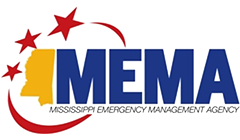At a Glance
The Office of Response at the Mississippi Emergency Management Agency has a single purpose: to ensure that government agencies and first responders are always ready to respond to critical events, equipped with the information they need to mitigate disasters. Originally, it achieved this through the Nixle crisis communications platform. However, when Nixle no longer met its needs, the agency turned instead to BlackBerry® AtHoc.
The Organization
The Mississippi Emergency Management Agency (MEMA) coordinates first responders and government organizations to respond to crises that include hazardous materials, natural disasters, and missing persons both from its State Emergency Operations Center (EOC) and through each county’s own local EOC. It works with public sector organizations throughout Mississippi such as emergency personnel, the Department of Transportation, the Department of Defense, and the Mississippi Civil Defense and Emergency Manager Association.
The Office of Response is perhaps MEMA’s most critical arm, responsible for keeping both state and local officials apprised of an impending disaster.
“When a disaster occurs, we coordinate the response in its early stages,” explains Thomas Brewer, GIS Technology Officer at MEMA. “We alert agencies across the state, ensuring everyone knows what they need to know. The Operations Bureau then takes over from there, getting everyone where they need to be.”
“When we’re notified by an agent in the field – either one of our own or someone from a different government department – we send an alert out to all MEMA employees as well as any relevant agencies in affected counties,” he continues. “Depending on severity, we may even notify a representative from the Department of Homeland Security or the Governor’s Office. We also receive alerts from various other governmental organizations which we rebroadcast.”
The Challenge
One of the most critical locales monitored by MEMA is Port Gibson. Home to the Grand Gulf Nuclear Station, its existence is one of the main reasons MEMA maintains a mass notification system. If something were to go wrong at Grand Gulf, government and emergency personnel throughout the state would need to know immediately – otherwise, the results could be catastrophic.
“The Grand Gulf Nuclear Station was a driving factor in our deployment of a mass notification system,” explains Brewer. “Because it’s there, it’s mandated that we use a crisis communications platform that’s highly robust, reliable, and flexible. If something happened down there, a delay of even a few seconds could lead to things ending very badly.”
Until 2016, MEMA handled alerting via the Nixle crisis communications platform. However, the agency realized it did not meet their requirements. They needed a solution with peerless reliability capable of sending alerts through a wide range of channels and of supporting SMS alerts.
Nixle did not offer this functionality, nor did it have a mobile app or integration with the Integrated Public Alert & Warning System (IPAWS). It was clear the agency needed a replacement, but they were uncertain of where to begin. Blackberry AtHoc was proposed as a viable solution by a MEMA employee familiar with its capabilities — and after a brief test period, this proposal proved to be the solution.
The Solution
A powerful crisis collaboration and communications tool, AtHoc is trusted by public safety organizations and the majority of United States government agencies to protect personnel and infrastructure during emergencies. With the capacity to send alerts through virtually any channel, AtHoc streamlines emergency collaboration through features like pre-configured templates and geolocation targeting. It also integrates with a range of different devices, systems, and platforms, including IPAWS.
Shortly after MEMA began the process of implementing AtHoc, the platform was ready for active use. This process included installation, building templates, and training administrators and operators. Throughout, BlackBerry played an active role, providing advice on both implementation and workflows.
The agency carried out its first full-scale Grand Gulf drill in February 2017, with its next drill scheduled for March 2019.
“If something goes down in Grand Gulf, it represents a full activation,” explains Brewer. “Name any state agency you can think of, and they’ll have a role in it. Having prepopulated templates definitely made the drill move more quickly, as did the ability to contact people through avenues other than email and text.”
In working with AtHoc’s deployment experts, MEMA created a total of 64 AtHoc templates. In addition to templates specifically related to Grand Gulf, it also has templates for a diverse range of events and incidents. These range from minor weather events to hazardous materials to natural disasters.
“Mississippi is impacted every year by numerous tropical and severe weather events, including life-threatening hurricanes and tornadoes,” says Brewer. “We now use AtHoc in conjunction with WebEOC software to manage events and disasters; we also share post-event damage reports with stakeholders via AtHoc for situational awareness.”
There are 150 MEMA employees on the AtHoc platform, 50 of whom have publishing rights for alerts. Overall, there are more than 2,000 users active on MEMA’s AtHoc deployment, employed at state and emergency agencies across Mississippi. Most notably, the state’s Search and Rescue task force is using AtHoc’s alerting and response verification functionality to better coordinate their search efforts. AtHoc achieves this in three ways: through secure, industry leading infrastructure, through the capacity to send alerts using different mediums, and through detailed notification reporting.
“The Office of Response has a seat at the table as far as coordination goes, and we’re responsible for sending out alerts to our stakeholders and emergency coordinating officials who respond if an event does occur,” explains Brewer. “Multiple events happen daily all across the state, the majority being hazardous materials and weather warnings. In 2017, we sent out 2,406 notifications total, 505 of which were hazardous materials warnings.”

The Results
Rapid Response: MEMA’s Office of Response is run by a relatively small number of workers. For each twenty-four-hour period, there are ten staff on rotation. It’s thus essential that they be able to send out alerts quickly, without having to spend a great deal of time manually editing each message.
AtHoc’s templates enable them to do exactly that, and AtHoc itself allows them to also track which recipients have received alerts and are able to respond.
“At the end of October, we had a severe weather outbreak,” recalls Scott Davis, Communications Bureau Director at MEMA. “It was just myself and two others in the operations center at the time. After being notified by the National Weather Service, we were able to issue 77 severe weather warnings to agencies across the state within probably two hours or so.”
Coordination & Collaboration: Time is especially critical in the early stages of an impending emergency, and disasters do not operate on a nine-to-five schedule. An agent may not always be within reach of their desk or near an operations center when an event occurs. With AtHoc, they don’t need to be.
“Our organization and the agencies we work with have multiple people in the field, all equipped with the mobile app,” explains Brewer. “The ability to send out an alert wherever and whenever an incident happens is literally in the palm of their hands. They don’t need to drive to an operations center or travel to the office; they can notify us immediately.”
Redundant & Reliable: A communications breakdown is one of the worst things that can happen in an emergency situation. MEMA needed a crisis communications platform able to guarantee delivery. AtHoc achieves this in two ways: through secure, industry-leading redundant infrastructure, and through the capacity to send alerts using different mediums and providing detailed notification reporting.
Organization Profile
Industry Public Sector
Location Mississippi
Users ~3,000
http://www.msema.org/
